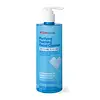What's inside
What's inside
 Key Ingredients
Key Ingredients

 Benefits
Benefits

 Concerns
Concerns

 Ingredients Side-by-side
Ingredients Side-by-side

Water
Skin ConditioningGlycerin
HumectantCetearyl Alcohol
EmollientPEG-40 Stearate
EmulsifyingPhenoxyethanol
PreservativeGlyceryl Stearate Se
EmulsifyingCarbomer
Emulsion StabilisingBehentrimonium Methosulfate
Stearyl Alcohol
EmollientCeramide NP
Skin ConditioningCeramide AP
Skin ConditioningCeramide EOP
Skin ConditioningPhytosphingosine
Skin ConditioningCholesterol
EmollientSodium Lauroyl Lactylate
EmulsifyingXanthan Gum
EmulsifyingSodium Hyaluronate
HumectantEthylhexylglycerin
Skin ConditioningSodium Hydroxide
BufferingTocopherol
AntioxidantWater, Glycerin, Cetearyl Alcohol, PEG-40 Stearate, Phenoxyethanol, Glyceryl Stearate Se, Carbomer, Behentrimonium Methosulfate, Stearyl Alcohol, Ceramide NP, Ceramide AP, Ceramide EOP, Phytosphingosine, Cholesterol, Sodium Lauroyl Lactylate, Xanthan Gum, Sodium Hyaluronate, Ethylhexylglycerin, Sodium Hydroxide, Tocopherol
Water
Skin ConditioningGlycerin
HumectantCoco-Betaine
CleansingSodium Lauroyl Methyl Isethionate
CleansingPropanediol
SolventPEG-120 Methyl Glucose Dioleate
EmulsifyingSodium Chloride
MaskingSodium Hydroxide
BufferingCitric Acid
BufferingCeramide NP
Skin ConditioningNiacinamide
SmoothingDisodium EDTA
Capryloyl Glycine
CleansingCaprylyl Glycol
EmollientAcrylates Copolymer
Chlorphenesin
AntimicrobialPhenoxyethanol
PreservativePEG-150 Distearate
EmulsifyingSodium Benzoate
MaskingWater, Glycerin, Coco-Betaine, Sodium Lauroyl Methyl Isethionate, Propanediol, PEG-120 Methyl Glucose Dioleate, Sodium Chloride, Sodium Hydroxide, Citric Acid, Ceramide NP, Niacinamide, Disodium EDTA, Capryloyl Glycine, Caprylyl Glycol, Acrylates Copolymer, Chlorphenesin, Phenoxyethanol, PEG-150 Distearate, Sodium Benzoate
Ingredients Explained
These ingredients are found in both products.
Ingredients higher up in an ingredient list are typically present in a larger amount.
Ceramide NP is a type of ceramide and formally known as ceramide 3.
Ceramides are intercellular lipids naturally found in our skin that bonds dead skin cells together to create a barrier. They are known for their ability to hold water and thus are a great ingredient for dry skin.
Ceramides are an important building block for our skin barrier. A stronger barrier helps the skin look more firm and hydrated. By bolstering the skin ceramides act as a barrier against irritating ingredients. This can help with inflammation as well.
If you would like to eat ceramides, sweet potatoes contain a small amount.
Read more about other common types of ceramides here:
Ceramide AP
Ceramide EOP
Glycerin is already naturally found in your skin. It helps moisturize and protect your skin.
A study from 2016 found glycerin to be more effective as a humectant than AHAs and hyaluronic acid.
As a humectant, it helps the skin stay hydrated by pulling moisture to your skin. The low molecular weight of glycerin allows it to pull moisture into the deeper layers of your skin.
Hydrated skin improves your skin barrier; Your skin barrier helps protect against irritants and bacteria.
Glycerin has also been found to have antimicrobial and antiviral properties. Due to these properties, glycerin is often used in wound and burn treatments.
In cosmetics, glycerin is usually derived from plants such as soybean or palm. However, it can also be sourced from animals, such as tallow or animal fat.
This ingredient is organic, colorless, odorless, and non-toxic.
Glycerin is the name for this ingredient in American English. British English uses Glycerol/Glycerine.
Learn more about GlycerinPhenoxyethanol is a preservative that has germicide, antimicrobial, and aromatic properties. Studies show that phenoxyethanol can prevent microbial growth. By itself, it has a scent that is similar to that of a rose.
It's often used in formulations along with Caprylyl Glycol to preserve the shelf life of products.
Sodium Hydroxide is also known as lye or caustic soda. It is used to adjust the pH of products; many ingredients require a specific pH to be effective.
In small amounts, sodium hydroxide is considered safe to use. However, large amounts may cause chemical burns due to its high alkaline.
Your skin has a natural pH and acid mantle. This acid mantle helps prevent harmful bacteria from breaking through. The acid mantle also helps keep your skin hydrated.
"Alkaline" refers to a high pH level. A low pH level would be considered acidic.
Learn more about Sodium HydroxideWater. It's the most common cosmetic ingredient of all. You'll usually see it at the top of ingredient lists, meaning that it makes up the largest part of the product.
So why is it so popular? Water most often acts as a solvent - this means that it helps dissolve other ingredients into the formulation.
You'll also recognize water as that liquid we all need to stay alive. If you see this, drink a glass of water. Stay hydrated!
Learn more about Water